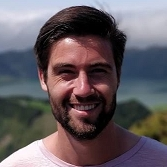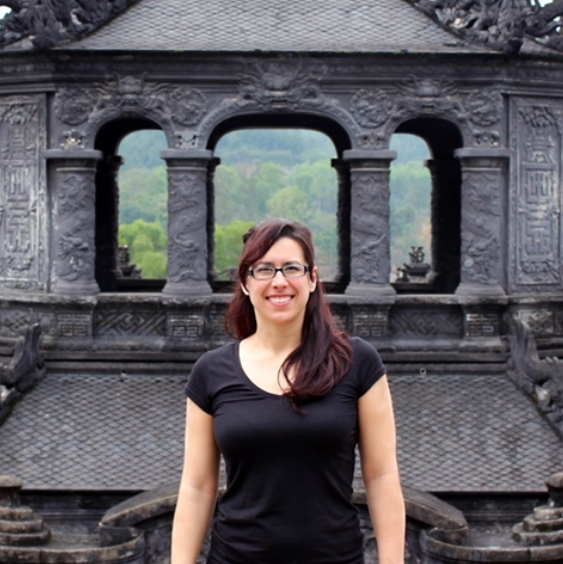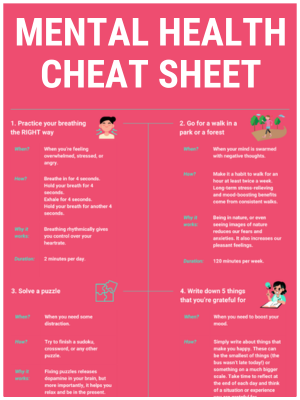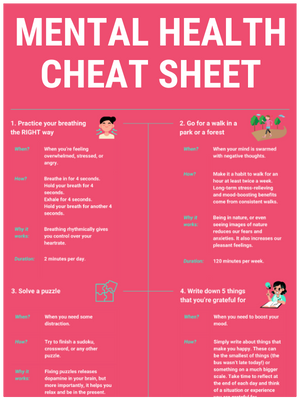Contents
Hello! Who are you?
Hello, my name is Robyn and I live in Alberta, Canada with my wonderful husband, and our 5-year-old feisty, stubborn dog, Leonardo.
For the past 14 years, I have been an English and Art teacher and even did a stint teaching abroad in China and Malaysia.
While I love photography and gymnastics, my biggest passion is travel. So far, I have explored 42 countries and been to 5 of the 7 continents.
I also live with fibromyalgia, chronic fatigue, and postural orthostatic tachycardia syndrome (POTS).
I definitely consider myself to be happy. I have always had a positive attitude and outlook on life. I love to laugh and try to find humor in every situation.
Despite significant setbacks and changes to my physical health, I am determined to keep smiling and follow my dreams. I want to live a life full of positivity, compassion, and as much adventure as I can.
💡 By the way: Do you find it hard to be happy and in control of your life? It may not be your fault. To help you feel better, we’ve condensed the information of 100’s of articles into a 10-step mental health cheat sheet to help you be more in control. 👇
What is your struggle and when did it start?
In February 2022, I was diagnosed with anxiety and forced to take time off work so I could prioritize my mental health.
My symptoms started with a warm, intense wave rushing over my whole body, followed by light-headedness and dizziness. Occasionally, that was accompanied by nausea and a mouth drier than a desert.
The worst symptom was the sharp chest pain and my pounding heart. Fear took over, which only exacerbated the horrible sensations I felt. I never understood why my body thought the best way to react to a perceived danger was to cause sudden chest pain and simulate a heart attack.
My anxiety developed over the course of a year, starting in the spring of 2021. In the span of 6 months, I experienced several health scares, including a severe reaction to the vaccine, costochondritis, a broken foot, and alarming chest pains.
This was the beginning of my anxiety incidents, as I like to call them.
No one understood what was happening to me. I completed anxiety and depression questionnaires and was sent for blood work, chest x-rays, and a mammogram, but everything came back normal. So, my doctor referred me to a specialist.
In the meantime, I kept pushing through the uncertainty and carrying on as if everything was fine. Even my work, which usually brought so much joy, became stressful and difficult. The more I pushed, the worse it got.
Regrettably, I did not recognize the tremendous strain and stress being put on my mental health. My mind screamed for help, but I didn’t listen. With each health scare, my self-confidence and happiness deteriorated, and my anxiety intensified.
When I visited my doctor again 4 months later, it was obvious I needed help. I took the anxiety questionnaire again, and this time, the results were indisputable.
How did this struggle make you feel at your worst moments?
After living with fibromyalgia and chronic pain for 20 years, I am an expert at hiding pain. So, unfortunately, hiding my growing anxiety from people around me was second nature.
That meant my family, friends, and work colleagues had no idea what I was going through. Only my husband knew what was happening to me.
But that also meant I felt more alone.
The anxiety and mental health struggles I experienced over the course of a year threw my life completely off balance. My anxiety was intrusive, overwhelming, and demanding.
I felt like a broken, empty version of myself, unable to identify the person I had become. The smile that was usually plastered on my face, felt permanently erased. My usual happy self was nowhere to be found.
I did not want this to be my life… but somehow it was.
Every anxiety incident left me feeling completely helpless like I was no longer in control of my body. I felt confused and alone each day with so many questions and no answers.
Even worse, I was scared to death that this anxiety, and its power over me, was never going to leave.
👉 Share your story: Help thousands of people around the world by sharing your own story. We would love to publish your interview and have a positive impact on the world together. Learn more here.
Was there a moment when you started to turn things around?
My anxiety and mental health struggle began because of the stress, fatigue, and unexplained changes to my body. Despite the anguish and confusion, I remained headstrong and determined to get help and rediscover my happy self.
My decision to step back from work and prioritize my mental health is where my path changed. I found a psychologist and put in the necessary effort, both during our sessions and at home.
For any therapy to work, you must be willing to open up and practice the techniques and strategies at home. So that is what I did, and after about 2 months, I started to recognize myself again.
Finally, I was making progress and starting to heal. My anxiety incidents became less intense and less frequent. I was able to visualize and calm myself sooner and with more success.
Then, nearly 14 months after my first health scare, the catalyst of my anxiety, I finally got my answer. The specialist I was referred to 9 months earlier diagnosed me with ME/CFS and POTS (postural orthostatic tachycardia syndrome), a form of dysautonomia. It is a malfunction of the Autonomic Nervous System that controls things like heart rate.
Symptoms include heart palpitations, light-headedness, extreme fatigue, nausea, dizziness, brain fog, chest pain, and shortness of breath. I was elated and so relieved to finally have an explanation for all the changes to my body over the past year.
My doctor explained that POTS is often misdiagnosed as anxiety since many symptoms overlap. Instead, she believed my anxiety was caused because of the unexplained body sensations I was experiencing.
Finally, my therapist ensured I had the necessary strategies and tools to recognize and halt my anxiety when those symptoms appeared. It has been a learning curve, but I feel back in control of myself and my happiness.
What steps did you take to overcome your struggle?
Step 1: When facing any mental health issue, seek support as soon as possible. You do not need to go through this alone.
Whether it be a spouse, family member, friend, or support group, find someone who will listen, empathize, and support you as you disentangle yourself from this nightmare. We are meant to go through life’s highs and lows together… not in isolation.
Step 2: Be open and willing to try everything to get yourself back on track, to a version of yourself that you recognize.
I wasn’t ready to accept anxiety as my life-long partner, so I was steadfast in discovering as many ways to tackle it as I could. In addition to the methods listed here, I also tried yoga, meditation, hypnotherapy, and medication.
Step 3: Download the DARE Response App. Besides talking to a therapist, the DARE app has been the most constructive, helpful, and successful strategy for dealing with anxiety that I discovered.
The exercises “walk you” through an anxiety incident as it is happening. Repetition and consistency are important. The more you listen to/watch the videos, the easier it is to re-train your brain.
Step 4: Learning a breathing/tapping technique was pivotal to my progress. When anxious, we breathe from our chest, instead of our belly. However, calm deep belly breaths bring oxygen to the brain, which slows or calms our fight or flight response during an anxiety incident.
My favorite technique involved breathing and tapping my belly and heart, while repeating, “I’m ok, I’m ok, I’m ok.” It is similar to Gary Craig’s EFT (emotional freedom technique).
Step 5: Finding a psychologist that I trusted was the crucial element to my success. Thankfully, I found Dr. C, who validated my feelings, listened to my concerns and offered a new perspective on my situation. I am a firm believer that talking helps heal our worried, anxious minds and heal our souls.
I tried Cognitive Behavioral Therapy (CBT) and Eye Movement Desensitization and Reprocessing (EMDR). I found both treatments to be highly effective and instrumental to my progress, healing and restoring my mental health.
a) CBT: This talking therapy centers around the interconnectedness of our thoughts, feelings, and behaviors. Dr. C used a Cognitive Triangle to explain how our mind affects our bodies and vice versa. Therefore, one negative/fearful thought can trigger a chain reaction of negative/fearful feelings and body reactions.
For me, my sudden chest pain triggered thoughts of a heart attack, which caused extreme fear, and amplified my body sensations. Hence, the chain reaction. This exercise taught me I was still in control, I just needed to retrain my brain and break the cycle.
b) EMDR: This treatment option targets a traumatic memory that is stored incorrectly in our brain, which can be the cause of some anxiety.
Through guided questions and rapid eye movement, you move through each trauma and the body sensations that accompany it. Although you are dealing with difficult, vivid memories, I found the experience incredibly enlightening and rewarding.
Have you shared any of this with people around you in real life?
My husband was the only person that knew what I was going through at the time. He witnessed my mental health struggles and was willing to do what was necessary to allow me an opportunity to heal.
I felt comfortable talking to him because he has been supportive of all my health issues over the years, and this was no different. Although he didn’t understand what was going on (along with myself!), he was a pillar of strength.
I am fortunate to have such a wonderful husband and I know that this journey would have been tremendously more arduous if he wasn’t by my side.
A few months into my anxiety journey, I shared my mental health struggle with my sister and friend/massage therapist. Although I knew they would have offered love and support from the beginning, I naively hoped I could figure it out on my own.
Sometimes, I felt that if I shared what was going on with my work colleagues, I would be perceived as weak. This only compounds the issue because you already feel so alone during this journey. This was even more burdensome because I needed to take a leave of absence from work to properly devote time and energy to myself.
The reality is you don’t always feel comfortable sharing this kind of information or a personal struggle with everyone in your life.
Society’s expectations about pushing through and toughing it out are ingrained in us and hard to ignore. And although the landscape is changing, there remains a stigma around mental health that I hope dissipates in the years to come.
If you could give a single piece of advice to someone else that struggles, what would that be?
The best piece of advice I could offer someone struggling with anxiety and mental health would be to take time for yourself. It can be extremely difficult to put ourselves first, but sometimes that is exactly what we need.
But grinding it out only deepens the stress on your physical body and mental health. There is only so much we can bear before we break.
My decision to make my mental health a priority was difficult at first, but I’m glad I did. I slowly learned that prioritizing yourself, and asking for help is not a sign of weakness, but a sign of strength.
And I know now that both my physical and mental body thanked me for taking the much-needed time and space to take care of myself.
It’s funny, we will take time off to address the needs of our physical health, like a broken leg or the flu, but not for our mental health. It’s unfortunate that so many people are encouraged to push through and stay in the rat race, only to succumb to a greater health concern down the road.
A year after this all began, I no longer feel like my anxiety dictates my day. My anxiety incidents are few and far between and I am now able to control them with more success.
I gained valuable insight into my triggers and how to control them before they get out of hand. I can honestly say that I am stronger, more confident, and more comfortable with who I am because I attended therapy. And that only happened because I took the time for myself.
What have been the most influential books, podcasts, YouTube channels, or other resources for you?
Although I did not look for a book or video about managing anxiety, I found the following resources very helpful and often used them in combination with one another.
- DARE Response App & Podcast: This was the most helpful and insightful resource I found to help manage my anxiety. The DARE Response is an evidence-based program designed to help people overcome anxiety, panic attacks, and insomnia. It helped me see my anxiety in a different light, and I learned to embrace my anxious energy instead of fearing it. I found the most success with the Dissolve Anxiety video, Deep Release exercise, and the entire SOS section of the app.
- Weighted Blanket: According to the Journal of Integrated Medicine, a weighted blanket uses deep pressure stimulation to calm the nervous system. I noticed an improvement in using my weighted blanket whenever my body was flooded with anxious feelings. It made me feel safe during those difficult moments.
- Essential Oils: I used lavender essential oils and bath salts when I felt particularly anxious. Lavender calms and relaxes the body by reducing our fight-or-flight response.
- Puzzles: Working on a puzzle during an anxiety incident provides a necessary distraction and takes my mind off the overpowering anxious feelings.
Where can we go to learn more about you?
This past year, my husband and I turned our passion into a travel blog, called Two Empty Passports, where we share travel guides, itineraries, and tips to help you plan your next big adventure.
Feel free to reach out by email anytime. You can follow my journey on Instagram too.
💡 By the way: If you want to start feeling better and more productive, I’ve condensed the information of 100’s of our articles into a 10-step mental health cheat sheet here. 👇
This Cheat Sheet Will Help You Be Happier and More Productive
Thrive under stress and crush your goals with these 10 unique tips for your mental health.
Want more interviews?
Continue reading our inspiring case studies and learn how to overcome mental health struggles in a positive way!
Want to help others with your story? We would love to publish your interview and have a positive impact on the world together. Learn more here.



